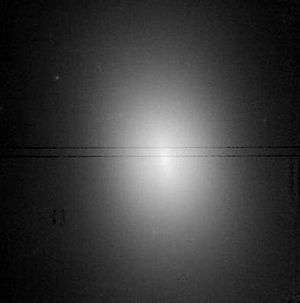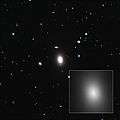NGC 1600
NGC 1600 is an elliptical galaxy in the constellation Eridanus, 200 Mly (61 Mpc) away from Earth.[5]
| NGC 1600 | |
|---|---|
 Image derived from data taken by the Hubble Space Telescope. | |
| Observation data (J2000 epoch) | |
| Constellation | Eridanus |
| Right ascension | 4h 31m 39.9s[1] |
| Declination | −5° 05′ 10″[1] |
| Redshift | 0.015614 [1] |
| Helio radial velocity | 4681 km/s [1] |
| Distance | 45,770 kpc (149,300 kly)[1] |
| Group or cluster | group [2] |
| Apparent magnitude (V) | 11.93[1] |
| Characteristics | |
| Type | E3[1][3] or E4 [4] |
| Mass | 1×1012 [2] M☉ |
| Mass/Light ratio | 10.58 [2] M☉/L☉ |
| Apparent size (V) | 2.5 x 1.7 arcminutes[1] |
| Other designations | |
| LEDA 15406,[3] PGC 15406[1] | |
Galaxy
Often described as being an isolated early-type galaxy,[2] it is known to have at least 30 fainter satellite galaxies, including NGC 1601 and NGC 1603.[2] The galaxy has been observed to have boxy isophotes[2] and little rotation.[4] The presence of H-alpha indicates possible ongoing star formation, and the galaxy is a known source of X-ray emissions.[2] It is believed that NGC 1600 is the product of a galaxy merger [4] which took place over 4 Gyr ago.[2] The age of the galaxy is estimated at 4.6 - 8.8 Gyr.[2]
Supermassive black hole
NGC 1600 has a diffuse distribution of stars near its center, caused by the influence of the galaxy's central black hole.[6] Despite NGC 1600 being of typical size, the supermassive black hole at its center is unusually large, with a mass of 17 billion solar masses (M☉),[6] making it one of the largest known.[7] At the time of the determination of the size of the black hole, in 2016, it was found to be unusual in its location in relation to the galaxy population of the region. Previously, extremely large black holes were only found in the hearts of large dense rich clusters, the galaxy group for which NGC 1600 is found is only an average galaxy group and not a rich cluster. This discovery could signify previously unknown populations of very large black holes, and that black hole growth models may be incorrect or incomplete.[5]
Gallery
 Elliptical galaxy NGC 1600 is 200 million light-years away.[8]
Elliptical galaxy NGC 1600 is 200 million light-years away.[8]
References
- "Results for NGC 1600". NASA/IPAC Extragalactic Database. Retrieved 2016-04-06.
- Smith, Rodney M.; Martínez, Vicent J.; Fernández-Soto, Alberto; Ballesteros, Fernando J.; Ortiz-Gil, Amelia (2008-05-20). "NGC 1600: Cluster or Field Elliptical?". The Astrophysical Journal. 679 (420): 420–427. arXiv:0802.1846. Bibcode:2008ApJ...679..420S. doi:10.1086/587454.
- "NGC 1600 -- Galaxy in Group of Galaxies". SIMBAD.
- Matthias, Michael; Gerhard, Ortwin (1999-12-11). "Dynamics of the boxy elliptical galaxy NGC 1600". Monthly Notices of the Royal Astronomical Society. 310 (3): 879–891. arXiv:astro-ph/9901036. Bibcode:1999MNRAS.310..879M. doi:10.1046/j.1365-8711.1999.03022.x. Retrieved 2016-04-06.
- Sarah Lewin (6 April 2016). "Humongous black hole catches astronomers totally off guard". SPACE.com. Christian Science Monitor.
- Thomas, Jens; Chung-Pei, Ma; McConnell, Nicholas J.; Greene, Jenny E.; Blakeslee, John P.; Janish, Ryan (2016-04-06). "A 17-billion-solar-mass black hole in a group galaxy with a diffuse core". Nature. 532 (7599): 340–342. arXiv:1604.01400. Bibcode:2016Natur.532..340T. doi:10.1038/nature17197. ISSN 0028-0836. PMID 27049949.
- Supersized black hole discovery forces universal rethink
- Jens Thomas; Mathias Jäger (6 April 2016). "Behemoth black hole found in an unlikely place". Hubble Space Telescope. heic1607. Retrieved 7 April 2016.